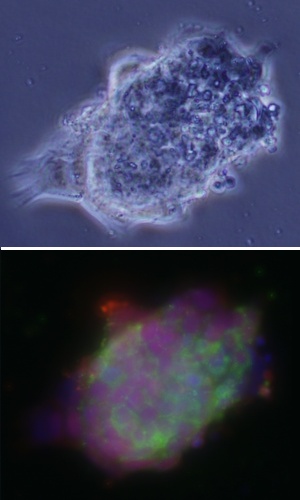
A colony of mouse embryonic stem cells before (top) and after (bottom) staining that indicates the presence of Oct4 (red) – a master gene that controls stem cell status. The molecular signaling researched by Lee and co-workers was found to regulate Oct4 expression and move cell activity from a state of self-renewal towards differentiation into specific cell types.
Cell biologists have spent years researching the processes that allow a fertilized egg to become a complex mammal. Different proteins trigger responses in embryos at different times, sending signals that allow simple cells to transform, or ‘differentiate’, into specialized cells. Two related proteins, Nodal and Activin, are thought to act as key signals in early cell differentiation. However, little is understood about exactly how cells know what they are being told to do.
Kian Leong Lee and co-workers at the A*STAR Genome Institute of Singapore working in collaboration with the National University of Singapore and other institutions in Russia, Sweden and the US have now completed a study of stem cell differentiation that highlights new details on how Nodal and Activin play their roles in cell fate decisions. They found that the strength of the signal generated by the proteins plays a key part in cell fate decisions. “The stem cells in an embryo are hardwired in their DNA to activate and shut down different genes at specific signaling levels,” says Lee. “When a dose of Nodal/Activin signal comes along, the cells detect this through receptors on the cell surface and relay the signal to their DNA .”
The researchers carried out experiments in which they exposed mouse embryonic stem cells to various levels of Nodal/Activin signaling. To obtain enough relevant DNA data, the researchers used hundreds of millions of mouse embryonic stem cells, and made use of advanced technologies to sequence all DNA fragments that were targeted by the Nodal/Activin signal in these cells. “It took a long time to produce results of the necessary quality, and lots of hardcore bioinformatics to process and make sense of all the sequencing data,” explains Lee.
The effort paid off in the end, with results showing that the right level of signalling from Nodal and Activin outside the cell generates a corresponding reaction from the protein Smad2 inside the cell. Smad2 responds to the signal by becoming phosphorylated, then travelling to the nucleus where it regulates the expression of genes that encourage the cell to either stay in its current state or differentiate into another cell type (see image).
According to Lee, the finding explains for the first time how a single signaling system remotely instructs stem cells to become specialized cells simply by the strength or weakness of the signal. He believes that the new insight will lead to safer stem-cell techniques for use in regenerative medicine. “Through this naturally occurring signaling system, we can instruct stem cells to become new types of cells without using any genetic modifications that are known to cause cancer,” says Lee.
The A*STAR-affiliated researchers contributing to this research are from the Genome Institute of Singapore.



